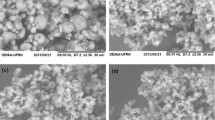Abstract
The solvent evaporation technique was employed to prepare poly(L-lactic acid) (PLA) microspheres with 165Ho acetylacetonate (Ho-AcAc). Particle size, percentage Ho-165, percent residual solvent, and retentive ability of the spheres were found to be strongly affected by preparatory conditions. Differential scanning calorimetry (DSC) thermograms suggested that the Ho-AcAc existed in the PLA matrix as a molecular dispersion. High neutron flux irradiations of the PLA spheres in a nuclear reactor produced Ho-166, a therapeutic radionuclide that emits high-energy negatrons (E max = 1.84 MeV; half-life = 26.9 hr). The gamma radiation dose (53– 75 Mrad) from the core of the reactor provided an overkill of all bioburdens in the PLA spheres. Gel permeation chromatography (GPC) analysis showed that these irradiations caused a reduction in PLA molecular weight. Infrared spectra, 13C NMR spectra, 1H NMR spectra, and DSC thermograms further confirmed the presence of lower molecular weight PLA but proved the overall maintenance of PLA structure.
Similar content being viewed by others
REFERENCES
G. J. Ehrhardt and D. E. Day. Therapeutic use of yttrium-90 microspheres. Nucl. Med. Biol. 14:233–242 (1987).
B. L. Prasad, M. S. Lee, and F. R. Hendrickson. Irradiation of hepatic metastases. Int. J. Radiat. Oncol. Biol. Phys. 2:129–132 (1977).
D. Cohn, H. Younes, and G. Marom. Amorphous and crystalline morphologies in glycolic acid and lactic acid polymers. Polymer 28:2018–2022 (1987).
K. Jamshidi, S. H. Hyon, and Y. Ikada. Thermal characterization of polylactides. Polymer 29:2229–2234 (1988).
S. D. Bruck and E. P. Mueller. Radiation sterilization of polymeric implant materials. J. Biomed. Mater. Res. Appl. Biomater. 22:133–144 (1988).
M. Asano, H. Fukuzaki, M. Yoshida, M. Kumakura et al. In vivo characteristics of low molecular weight copoly(D,L-lactic acid) formulations with controlled release of LH-RH agonist. Biomaterials 10:569–573 (1989).
J. M. Schakenraad, J. A. Oosterbaan, P. Nieuwenhuis, I. Molenaar et al. Biodegradable hollow fibres for the controlled release of drugs. Biomaterials 9:116–120 (1988).
H. Fukuzaki, M. Yoshida, M. Asano, M. Kumakura et al. In vivo characteristics of low molecular weight copolymers composed of L-lactic acid and various DL-hydroxy acids as biodegradable carriers for drug delivery systems. Biomaterials 11:441–446 (1990).
G. Spenlehauer, M. Vert, J. P. Benoit, and A. Boddaert. In vitro and in vivo degradation of poly(D,L lactide/glycolide) type microspheres made by solvent evaporation method. Biomaterials 10:557–563 (1989).
G. Spenlehauer, M. Vert, J. P. Benoit, F. Chabot, and M. Veillard. Biodegradable cisplatin microspheres prepared by the solvent evaporation method: Morphology and release characteristics. J. Control. Release 7:217–229 (1988).
W. B. Brown, J. F. Steinbach, and W. F. Wagner. Extraction of the lanthanides with acetylacetone. J. Inorg. Nucl. Chem. 13:119–124 (1960).
L. R. Beck, D. R. Cowsar, D. H. Lewis, J. W. Gibson, and C. E. Flowers. New long-acting injectable microcapsule contraceptive system. Am. J. Obstet. Gynecol. 135:419–426 (1979).
S. Y. Lin, L. T. Ho, and H. L. Chiou. Microencapsulation and controlled release of insulin from polylactic acid microcapsules. Biomat. Med. Dev. Art. Org. 13:187–201 (1985–1986).
J. P. Benoit, F. Courteille, and C. Thies. A physiochemical study of the morphology of progesterone-loaded poly (D,L-lactide) microspheres. Int. J. Pharm. 29:95–102 (1986).
T. R. Tice and R. M. Gilley. Preparation of injectable controlled-release microcapsules by a solvent-evaporation process. J. Control. Release 2:343–352 (1985).
A. Kishida, J. B. Dressman, S. Yoshioka, Y. Aso, and Y. Takeda. Some determinants of morphology and release rate from poly(L)lactic acid microspheres. J. Control. Release 13:83–89 (1990).
Author information
Authors and Affiliations
Rights and permissions
About this article
Cite this article
Mumper, R.J., Jay, M. Poly(L-lactic Acid) Microspheres Containing Neutron-Activatable Holmium-165: A Study of the Physical Characteristics of Microspheres Before and After Irradiation in a Nuclear Reactor. Pharm Res 9, 149–154 (1992). https://doi.org/10.1023/A:1018908600711
Issue Date:
DOI: https://doi.org/10.1023/A:1018908600711




